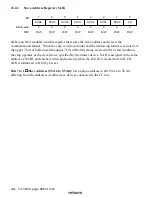
Rev. 1.0, 02/00, page 450 of 1141
22.4
SCI Interrupts
The SCI has four interrupt sources: the transmit-end interrupt (TEI) request, receive-error interrupt
(ERI) request, receive-data-full interrupt (RXI) request, and transmit-data-empty interrupt (TXI)
request. Table 22.12 shows the interrupt sources and their relative priorities. Individual interrupt
sources can be enabled or disabled with the TIE, RIE, and TEIE bits in SCR1. Each kind of
interrupt request is sent to the interrupt controller independently.
When the TDRE flag in SSR1 is set to 1, a TXI interrupt request is generated. When the TEND
flag in SSR1 is set to 1, a TEI interrupt request is generated.
When the RDRF flag in SSR1 is set to 1, an RXI interrupt request is generated. When the ORER,
PER, or FER flag in SSR1 is set to 1, an ERI interrupt request is generated.
Table 22.12 SCI Interrupt Sources
Channel
Interrupt Source
Description
Priority*
ERI
Interrupt by receive error (ORER, FER, or PER)
RXI
Interrupt by receive data register full (RDRF)
TXI
Interrupt by transmit data register empty (TDRE)
1
TEI
Interrupt by transmit end (TEND)
High
Low
The TEI interrupt is requested when the TEND flag is set to 1 while the TEIE bit is set to 1. The
TEND flag is cleared at the same time as the TDRE flag. Consequently, if a TEI interrupt and a
TXI interrupt are requested simultaneously, the TXI interrupt will have priority for acceptance,
and the TDRE flag and TEND flag may be cleared. Note that the TEI interrupt will not be
accepted in this case.














































